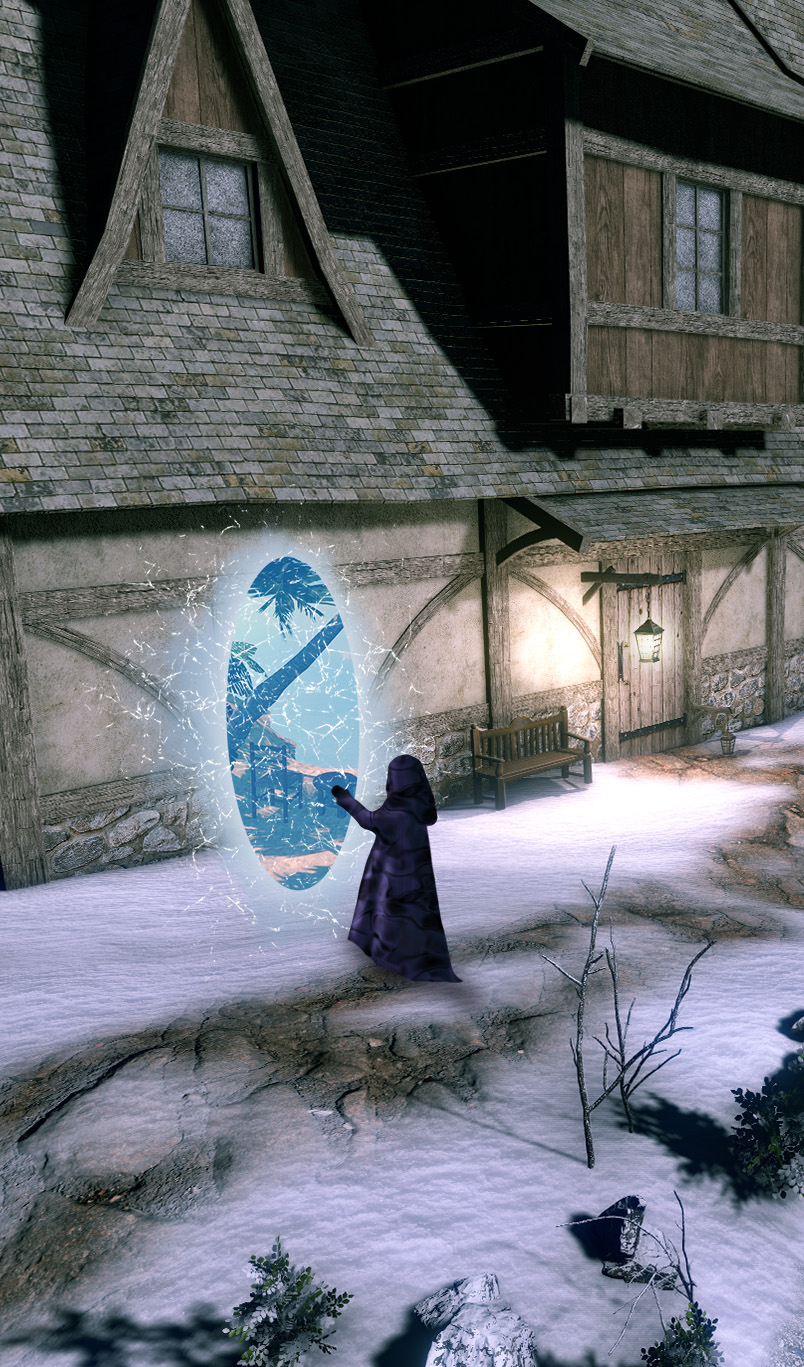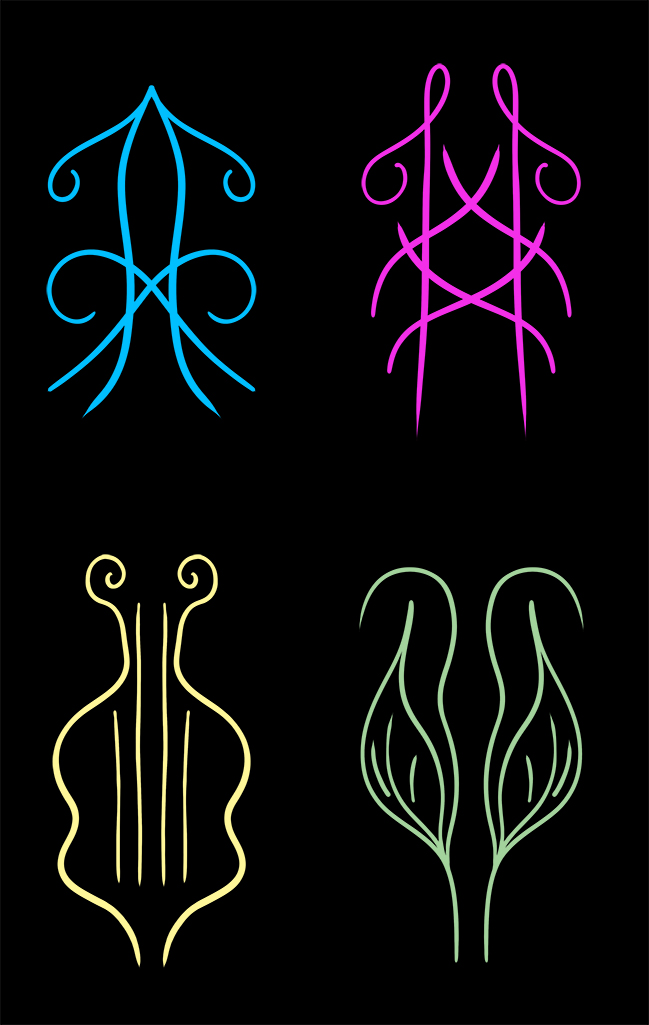Kick-portals
The way is open to those who chance the mists. It is not a light undertaking.
~~Ceaque
History
Sylfaodolon claim that Ceaque implemented the first kick-portal, shortly after he created the twilight mists. He wished for a faster way to traverse between far-distant places on Elthessera.
Over the millennia, mortals have continuously claimed that their deity gifted their religious order with the magickal means of travel, proving their holy worth (very conveniently, of course). Various mystery arts traditions take credit for the mode of transportation, muddying the waters. Modern scholars have traced the different incarnations of kick-portals back at least sixteen thousand years, and the mentions in those ancient texts refer to lost other books that also speak of them.
The Well has several dragon-ancient volumes in its libraries that refer to the wielding, but they do not list anyone but Ceaque as having developed it.
Description
A kick-portal is a wielding that mystery artists use to quickly traverse long distances with one step.
They have an inception site, a reception site, and the twilight mists to smooth the way between. When wielded, they look like a glowing oval doorway that hovers mid-air. They allow 1-2 people through at a time; larger portals are unstable. Sometimes the oval is transparent and shows the reception place, but most often it simply glows bright.
Since non-wielders cannot sense magick, those who initiate the kick-portal will add color to the spell, which allows all using it to see it.
How Kick-portals Work
- A wielder must find an appropriate inception site. It needs to be out of the way, so random someones don't accidentally walk into the kick-portal.
- A wielder must either know the reception site or use a hook to reach it. Hooks are the safest means of reaching a reception site, but if a wielder knows the area very well (like their bedroom) a hook is not needed.
- Once wielders have a pathway between the inception site and the reception site, they scry the reception site to see if it is occupied. Unfortunately the spell is limited. Long distances and outside interference tend to produce inaccurate assessments, especially for crowded areas like cities. A wielder never knows for certain whether someone or something has occupied the space until they open the kick-portal.
- A single wielder must initiate the spell to open a kick-portal. It is a complicated, if short, wielding. The first shadowartist, Muiodhin Muhiendhioh, described it as shoving your magickal hands through an unrealized slit in the air, then forcing the sides to open and straining to hold them in place while your power passes through the twilight mists and to the exit, where you repeat the process. Holding a portal, especially for an extended period of time, can drain a wielder fast. The slits that are open want nothing more than to close, and it is a battle to make sure that doesn't happen until everyone has passed through.
- The oval doorway hovers just above the ground, fed magick by the one who created it. If that wielder depletes their magick, other mystery artists can feed them power or they can draw from an object, pool or lake.
- A kick-portal cannot be handed off to another being. If the original wielder breaks contact, it collapses.
- When the way is open, a person steps through the glowing oval as if it were a doorway, and exits into the reception site. Ideally, this place is out of the way as well, because one does not want to open a portal inside an innocent passer-by.
- Once all others are safely through, the wielder steps through (or stays at the inception site, depending on the situation). They draw their magick back into themselves; without magick to hold it open, the kick-portal closes, leaving nothing to suggest it existed.
Only the most powerful mystery artists can create kick-portals due to the drain on an individual's magick well. If a wielder becomes tired, the magick feeding the portal wavers or stutters. If it's bad enough, the portal closes and anyone trapped between when it collapses is transported to the Void.
The distance between the inception and reception sites of a kick-portal are limited only by the wielder's magickal well. The longer the distance, the more of a drain on energy. That being said, some mystery artists, afraid of creating a kick-portal that spans too much distance, keep their travel short and confined to the breadth of a city, or the length of a valley. Some, however, travel continents.
Sylfaodolon create permanent kick-portals from their platforms to their demenses in Arberiss. Scholars are not certain of the distance between, but it is immense. This form of transit uses a hook.
While governments are interested in finding a way to quickly transport soldiers from one place to another, large kick-portals have never proven stable enough for armies to pass through at once. This affects beings as large as dragons, and only one can use the kick-portal at any given moment.
Examples of glyphs. While they can be as simple as a line or circle, most mystery artists like complicated designs.
Hooks
Hooks are the way wielders can access reception sites they have never visited. They are a magickal glyph and can be attached to anything, though most wielders prefer to place them on something solid that is not likely to move, like the side of a building.
There are two parts to a hook:
- The inception glyph
- The reception glyph
When Things Go Wrong
The Typical
- Opening and holding a portal takes a lot of magickal energy. A wielder might become exhausted enough the portal collapses. If someone steps through at this unfortunate time, they can be cut in half or sent to the Void.
- If a wielder without enough power opens a portal, it can easily become unstable. That is why only those with the deepest wells attempt it.
- Mystery artists must pay close attention as they open the reception place slit, and if something seems wrong, to stop. In very unfortunate circumstances, they might accidentally tear open the insides a person standing at the wrong place at the wrong time.
- The Void is just that: a place of inbetween with no light, no sound, no smell. The only beings on Elthessera who understand its true nature are the Five Originators. Of them, only Ceaque has entered it--and he refuses to return.
Mystery artists have attempted assassination through kick-portal, but the movement of a target combined with the resistance of opening a kick-portal in something solid rather than air, makes it a less than ideal tactic. It's far simpler to kick-portal near the target and then use offensive magicks.
Tears
A misformed kick-portal is called a tear. The magick used to create it warps; this can happen at anytime during the process, when one or both doorways are open. In the best case scenario, the portal closes. In the worst, it explodes, causing destruction in the sunlit realm at both the inception and reception sites, as well as the twilight mists and the twilight realm, which share the same space, but on separate layers.
This explosion can be devastating. Entire cities can be wiped away in the blink of an eye. Militaries have long sought to harness this destructive accident, but no one has ever found a way to only blow up the reception site; the inception site always goes with it.
Tears are extremely difficult to close. Kick-portals do not fail in the same way, and the tear may explode before interested parties discover the problem. Even when they find the problem, they may not be able to fix it in time.
Tears are exceptionally good at ripping through shielding, no matter the strength of the mystery artist who wielded them. It's almost accepted as fact, that no one but a sylfaone can protect themselves from an explosive tear.
While not every tear explodes, it is a danger every wielder needs to carefully consider before they attempt to create a kick-portal. Even those who use them so often they are considered a routing spell, can make a disasterous mistake.





Comments